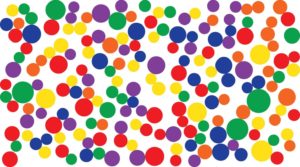In July, I posted the second part of the Pursuit of Happiness series, a subject I am passionate about. For the rest of the summer, however, I just could not bring myself to write the next installment. We faced some personal challenges and the uncertainty of things led to some sleepless nights and dark days. I was on edge more often than I’d like to admit. A sense of wellbeing eluded me. I concluded that happiness simply cannot happen when life doesn’t go our way. I resigned to the thought that I had no ground to write about HAPPINESS.
Until one day last week.
It was a bad morning. I didn’t sleep well and I was not looking forward to starting my day. I felt very out of sorts. I didn’t know what it was until I realized I was going through a series of anxiety attacks. I felt tense, irritable, and depressed.
After trying everything under the sun for relief and found none, I turned to Google in my moment of crisis. “Anxiety and depression…” I typed in the search bar. I was then drawn to a soothing female voice talking about a cure. She shared her story of anxiety, and she said she discovered a 7-step program that worked without any pills. She sounded knowledgeable enough. She assured her listeners that it is not a scam. As she kept on talking about how well her program works, I began to get impatient. “Just give me the 7 steps already, lady!” Finally, after 10-15 minutes, she was ready to close the deal. “With just $78 I will be able to send you…” I immediately closed the website and silenced her pitch. I was too smart to give my credit card number to a lady on the internet – even if she has THE cure.
She did reward my patience with a piece of helpful information. It gave me an insight and idea to write Part III of this Happiness series.
“It’s unnatural and even harmful to intentionally suppress feelings of anxiety or panic. Anxiety and panic are the two most useful emotions we have to keep us alive,” the $78-dollar lady said.
When we face a threatening situation, such as seeing a black bear approaching our toddler, our brain immediately releases stress hormones and triggers a fight-or-flight response. We either pick up a baseball bat to attack the bear or we grab our kid and run.
What is Anxiety Disorder? It is what happens to us when our brain releases these all-too-important stress hormones at the wrong place and at the wrong time.
That was how I understood what was happening with me that morning. My brain was interpreting a situation that was equivalent to seeing my child mauled by a bear over and over again! No wonder I felt I was about to fall apart. There was no real threat, but my brain was somehow hijacked and it refused to distinguish a real threat from a false alarm.
Before we get too excited about the next version of iOS or Windows, or over a livelier Siri or another form of A.I., we should take a moment to marvel at the most powerful computer that was ever made. It is sitting inside our heads. Our brain is capable of processing 400 billion bits of information per second. It can recognize a face instantly and it’s faster than any facial recognition program.
So the question is, what are we feeding this amazing machine called BRAIN?
I read an article a few months ago, and I found it quite fascinating. I will use it to demonstrate a point.
There is a number hidden in the dots below. What number do you see?

Give it a second before you continue. Really look. I’ll wait.
Did you see the 7, starting from the orange circles at left? Or maybe the 5, which starts at the purple circle in the center-right. Or maybe you didn’t see any number at all. Maybe you tried, but nothing jumped out at you.
There would a good reason for that: There is no number hidden in the dots. It’s just a randomly generated set of dots.
If you did see a number, you’ve proved the point that I hoped to make: When you’re looking for a pattern in a random set of data, you can often find it — especially if you have a lot of data to work with.
(Written by Philip Bump, National Correspondent, Washington Post)
You will always find what you’re looking for if you look hard enough. Pick a theory that you want to believe in and you will find someone backing it up on the internet. Don’t believe everything you read online. Better yet, don’t read, period.
Many years ago my doctor gave me a diagnosis after a routine examination. As much as it worried me, she assured me it was treatable. “And don’t go and research it on the internet,” she added. The skepticism in us might dismiss comments like this; we assume the doctor was probably feeling insecure, threatened by the web and its wealth of knowledge. (Sometimes we think we can google our way to become a licensed medical professional.)
I made the mistake of googling my symptoms. Tragically, I was led to believe I was having x, y, and z. I then had a panic attack and I drowned myself in a pool of tears thinking my children will grow up without their mother.
I was feeding my brain unsustainable, unverified half-truth, so it responded the way it is designed. A threat was perceived. Then our brain released stress hormones and increased the production of tears.
The doctor was right. What will eventually do us in is probably not the symptoms but the stress that comes from the unnecessary input of information.
I didn’t have any anxiety issues until I experienced the lasting effect of trauma in my mid-20s. Perhaps it was overwork, stress, and fatigue, I developed vertigo. I wondered often what would happen if I were to have an episode while driving. Then it happened in 1996. I was driving a rental car from Chicago to Madison, WI, with a friend. I felt an onset of vertigo and in a panic, I swerved the car to the right and pulled to the side of the road on a two-lane highway. The car behind me didn’t have enough time to react. Its poor driver slammed on the brake so hard and fast that the car ended up spinning. I watched in horror through the rear-view mirror. My friend and I were drenched in two cups of fresh, hot coffee that spilled all over us.
I have not been able to drive on the highway since. And I feel uneasy whenever I see coffee cups and mugs without the lids in a vehicle. One of the best gifts I ever received was from one of my aunts in Taiwan – a lily pad suction lid made in Germany.

Trauma is almost like a computer glitch that gets called up every time the brain senses a familiar situation. Case in point, whenever I am behind the wheel on a wide, busy road, my brain would send a signal that says something like this. “Near accident. Year 1996. Extreme danger. Loss of life possible.” My hands would get clammy, my heart would pound rapidly, and worst of all, I would start to hyperventilate.
There is hope, folks! Our brain is not static but dynamic and impressionable. We CAN neutralize these overactive panic and anxiety responses and return them to normal levels. We CAN reprogram our minds.
For the first time, I learned how to powerfully apply Romans 12:2.
“Do not conform to the pattern of this world, but be transformed by the renewing of your mind. Then you will be able to test and approve what God’s will is—his good, pleasing and perfect will.”
I can re-program my brain. I can teach it to interpret and assess a situation correctly. I can create new and updated files for it to process and retrieve.
I started by going down my list of triggers – situations that have pushed me over the edge. With each trigger, I explained logically to my brain why it is not a real threat and I offered reasons. I spoke out loud so my brain could hear me talk. I was telling this supercomputer what files to delete and what files to add.
Besides the fear of driving on the highway, I also dread being stuck near a busy intersection. Once I almost hyperventilated while waiting for the green light on Northern Boulevard and Lakeville Road. I was about to abandon my car and run out to the street. I held on to the steering wheel and waited anxiously for the traffic light to turn green.
In spite of the horror, I did get home safely that day. I reprogrammed my mind with logic and reason, and I got back on the road the next day. There I was, stuck on Horace Harding and Springfield Boulevard with lots of afterschool congestion in the middle of the afternoon. Yet, I was calm. I smoothly maneuvered my minivan amidst large trucks and buses in heavy traffic.
What did I tell myself?
I am in full control of the car. I am a good and experienced driver. My minivan is big and old, safe, and cheap.
“Happy is the man who finds wisdom, and the man who gains understanding.” (Proverbs 3:13)
I had a sweet, sweet taste of victory.
I don’t know what pointers I’d have received for $78 from the lady with a soothing voice. But I am offering my tips to you for free! It will only take three steps:
Step 1: Write down the triggers that have caused you panic/anxiety attacks. Then write out reasons to explain why they are not real threats. This is your neutralizing plan.
Step 2: Recall past incidents that might have traumatized you and contributed to any irrational reactions. Tell your brain to delete that glitch. Then tell it to insert a new file from Step 1. (Of course, we probably will never forget some of these incidents, but the new file should come up first to prepare you for a calmer response)
Step 3: While you are calm, review the neutralizing plan and say it to yourself as often as possible.
Don’t wait until you have a full-blown anxiety attack to reason your way out of trouble. It won’t work. Your brain would have already been in a fully protective, survival mode, and once a lion is released, you can’t get it to go back to the cage. You will have to let your lion roar and pounce around while you breathe your way back to calmness. You can count on your body to return to normal. You can trust the body created by the all-powerful God.
“For God has not given us the spirit of fear; but of power, and of love, and of a sound mind.” (2 Timothy 1:7)
